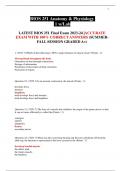Exam (elaborations)
Advanced Health Assessment & Clinical Diagnosis in Primary Care 6th Edition Dains Test Bank (Correct Answers)
- Module
- Institution
- Book
Advanced Health Assessment & Clinical Diagnosis in Primary Care 6th Edition Dains Test Bank Full Test bank correct answers
[Show more]












